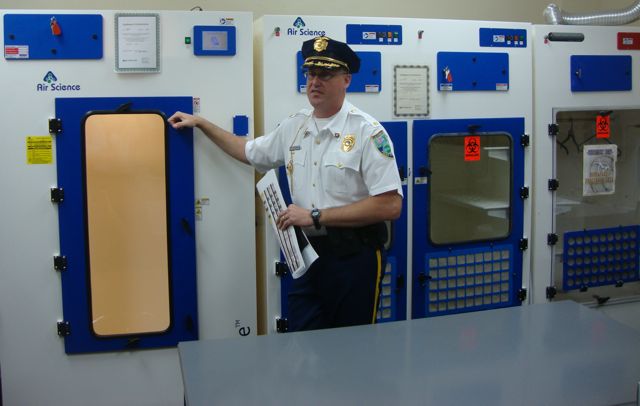
Gov. John deJongh Jr., accompanied by a swarm of media Wednesday, toured the nearly complete St. Croix lab. The tour was conducted by St. Croix Deputy Chief Christopher Howell, who oversaw the 14-month project, Police Commissioner Novelle Francis and St. Croix Chief Oakland Benta.
While it’s not as large or as grand as the lab sets TV viewers might see on such shows as "CSI" and "Bones," it has much of the same equipment and capabilities. In fact, some of the equipment is exactly the same as seen on television. It’s a far cry from the shabby evidence storage that had been condemned in three Interior Department audits dating back to 1994.
The two new labs have been budgeted for $500,000 each, Francis said. So far about $400,000 has been spent on the St. Croix facility, and the commissioner said he expected both to come in under budget. Work on the St. Thomas lab is slightly behind the work on St. Croix.
The new facility is protected by layers of security that begin with a scanner that reads the thumbprint of the person who is trying to gain access. If a person is authorized to enter, the door will open. If he or she is not, the door remains closed and the system records the thumbprint of the unauthorized person who tried to get in.
Inside, individual areas are similarly protected. A person whose thumbprint grants access to the general evidence area, for instance, can’t necessarily gain access to the ballistics lab or the "extreme value evidence" storage without clearance.
Within the separate areas, it’s all high tech. The walls might not be gleaming chrome and glass as on "CSI," but the equipment for lifting latent fingerprints, comparing ballistics or drying blood stains or preserving DNA is exactly the same.
More important than the television comparisons, Howell said, the facility is up to all standards set by both the Occupational Safety and Health Administration and the International Association of Property and Evidence.
"The facility will be unmatched in the Caribbean," Howell said.
The firearms and ballistics lab has equipment for matching bullet and shell casing markings and comparing them to known weapons. It also has equipment that can recover registration numbers from guns that have had the numbers obliterated or filed off. A water tank allows the staff to fire high-powered rifles, up to .50 caliber, while handguns can be tested in a ballistics tube, or "bullet catcher," a tube not more than two feet long and about six inches in diameter. Markings from those weapons can then be compared to bullets and casings from crime scenes. And those results also can be entered into a computer system that compares them to weapons from all over the United States.
Already, Howell said, the ballistics lab has found matches between confiscated weapons and crime scenes. One has been linked to three homicides, he said.
Francis said having the latest equipment and a staff trained to use it will make a "tremendous" difference in the ability to identify, apprehend and prosecute criminals.
Benta and Francis praised Howell for his work overseeing the project, noting that this was done on top of his other, regular police duties. They also credited deJongh with being the driving force in finding the money during difficult budget times and making the project a priority.
Sign in
Welcome! Log into your account
Forgot your password? Get help
Create an account
Privacy Policy
Create an account
Welcome! Register for an account
A password will be e-mailed to you.
Privacy Policy
Password recovery
Recover your password
A password will be e-mailed to you.


